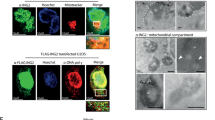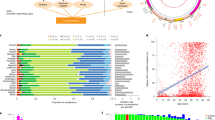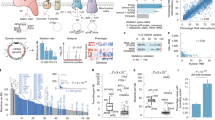Abstract
Mitochondrial defects have long been suspected to play an important role in the development of cancer. Although most cancer cells harbor somatic mutations in mitochondrial DNA (mtDNA), the question of whether such mutations positively contribute to the development of cancer remained unclear. To clarify the role of mutant mtDNA excluding effects by the nuclear background, we focus on a method of transmitochondrial cybrids. Tumors were formed by transplanting cybrids with or without mutant mtDNA into nude mice and compared each size, revealing that mutant cybrids enhanced tumorigenesis. Next, we discuss a method for excluding the possibility of secondary nuclear mutations that may affect tumorigenesis. Mitochondrial genes that had been converted from mitochondrial to nuclear codons and equipped with a mitochondrial-targeting sequence were introduced into the nucleus of mutant cybrids. The gene products complemented the dysfunction, and reduced the promotion of tumors. By these methods, we concluded that mutant mitochondria positively and directly contribute to tumorigenesis. Since apoptosis occurred less frequently in the mutant versus wild-type cybrids in tumors, pathogenic mtDNA mutations contribute to the promotion of tumors by preventing apoptosis. Finally, we discuss the role of mutant mtDNA in conferring tolerance against anticancer drugs.
This is a preview of subscription content, access via your institution
Access options
Subscribe to this journal
Receive 50 print issues and online access
$259.00 per year
only $5.18 per issue
Buy this article
- Purchase on Springer Link
- Instant access to full article PDF
Prices may be subject to local taxes which are calculated during checkout





Similar content being viewed by others
References
Amuthan G, Biswas G, Zyang SY, Klein-Szanto A, Vijayasarathy C, Avadhani NG . (2001). EMBO J 20: 1910–1920.
Attardi G, Schatz G . (1988). Annu Rev Cell Biol 4: 289–333.
Attardi G, Yoneda M, Chomyn A . (1995). Biochim Biophys Acta 1271: 241–248.
Bayona-Bafaluy MP, Manfredi G, Moraes CT . (2003). Nucl Acids Res 31: e98.
Biswas G, Guha M, Avadhani NG . (2005). Gene 354: 132–139.
Carew JS, Huang P . (2002). Mol Cancer 1: 9.
Chomyn A, Meola G, Bresolin N, Lai ST, Scarlato G, Attardi G . (1991). Mol Cell Biol 11: 2236–2244.
Coller HA, Khrapko K, Bodyak ND, Nekhaeva E, Herrero-jimenez P, Thilly WG . (2001). Nat Genet 28: 147–150.
Cuezva JM, Chen G, Alonso AM, Isidoro A, Misek DE, Hanash SM et al. (2004). Carcinogenesis 25: 1157–1163.
Cuezva JM, Krajewska M, de Heredia ML, Krajewski S, Santamaria G, Kim H et al. (2002). Cancer Res 62: 6674–6681.
D'Aurelio M, Gajewski CD, Lin MT, Mauck WM, Shao LZ, Lenaz G et al. (2004). Hum Mol Genet 13: 3171–3179.
Desjardins P, de Muys JM, Morais R . (1986). Somat Cell Mol Genet 12: 133–139.
DiMauro S, Bonilla E, Zeviani M, Nakagawa M, DeVivo DC . (1985). Ann Neurol 17: 521–538.
Dunbar DR, Moonie PA, Jacobs HT, Holt IJ . (1995). Proc Natl Acad Sci USA 92: 6562–6566.
Evans AR, Limp-Foster M, Kelley MR . (2000). Mutat Res 461: 83–108.
Fliss MS, Usadel H, Caballero OL, Wu L, Buta MR, Eleff SM et al. (2000). Science 287: 2017–2019.
Geromel V, Kadhom N, Cebalos-Picot I, Ouari O, Polidori A, Munnich A et al. (2001). Hum Mol Genet 10: 1221–1228.
Ghelli A, Zanna C, Porcelli AM, Schapira AH, Martinuzzi A, Carelli V et al. (2003). J Biol Chem 278: 4145–4150.
Guy J, Qi X, Pallotti F, Schon EA, Manfredi G, Carelli V et al. (2002). Ann Neurol 52: 534–542.
Hayashi J, Ohta S, Kikuchi A, Takemitsu M, Goto Y, Nonaka I . (1991a). Proc Natl Acad Sci USA 88: 10614–10618.
Hayashi J, Ohta S, Takai D, Miyabayashi S, Sakuta R, Goto Y et al. (1993). Biochem Biophys Res Commun 197: 1049–1055.
Hayashi J, Tanaka M, Sato W, Ozawa T, Yonekawa H, Kagawa Y et al. (1990). Biochem Biophys Res Commun 167: 216–221.
Hayashi J, Yonekawa H, Watanabe S, Nonaka I, Momoi M, Kagawa Y et al. (1991b). Somatic cell genetical approaches to mitochondrial diseases. In: Sato T, DiMauro S (eds). Progress in Neuro-pathology. Raven: New York, pp 93–102.
Hayashi JI, Takemitu M, Nonaka M . (1992). Somatic Cell Mol Genet 18: 123–129.
Holt IJ, Harding AE, Petty RK, Morgan-Hughes JA . (1990). Am J Hum Genet 46: 428–433.
Inoue K, Ito S, Takai D, Soejima A, Shisa H, LePecq JB et al. (1997). J Biol Chem 272: 15510–15515.
Isidoro A, Martinez M, Fernandez PL, Ortega AD, Santamaria G, Chamorro M et al. (2004). Biochem J 378: 17–20.
King MP, Attardi G . (1989). Science 246: 500–503.
King MP, Koga Y, Davidson M, Schon EA . (1992). Mol Cell Biol 12: 480–490.
Klein TM, Fitzpatrick-McElligott S . (1993). Curr Opin Biotechnol 4: 583–590.
Kujoth GC, Hiona A, Pugh TD, Someya S, Panzer K, Wohlgemuth SE et al. (2005). Science 309: 481–484.
Lee SR, Kwon KS, Kim SR, Rhee SG . (1998). J Biol Chem 273: 15366–15372.
Lightowlers RN, Chinnery PF, Turnbull DM, Howell N . (1997). Trends Genet 13: 450–455.
Linnartz B, Anglmayer R, Zanssen S . (2004). Cancer Res 64: 1966–1971.
Liu VW, Shi HH, Cheung AN, Chiu PM, Leung TW, Nagley P et al. (2001). Cancer Res 61: 5998–6001.
Manfredi G, Fu J, Ojaimi J, Sadlock JE, Kwong JQ, Guy J et al. (2002). Nat Genet 30: 394–399.
Matsuzawa A, Saegusa K, Noguchi T, Sadamitsu C, Nishitoh H, Nagai S et al. (2005). Nat Immunol 6: 587–592.
Maximo V, Soares P, Lima J, Cameselle-Teijeiro J, Sobrinho-Simoes M . (2002). Am J Pathol 160: 1857–1865.
McCord JM . (2000). Am J Med 108: 652–659.
Michiels C, Minet E, Mottet D, Raes M . (2002). Free Radic Biol Med 33: 1231–1242.
Moraes CT, Dey R, Barrientos A . (2001). Methods Cell Biol 65: 397–412.
Morais R, Zinkewich-Peotti K, Parent M, Wang H, Babai F, Zollinger M . (1994). Cancer Res 54: 3889–3896.
Nakano K, Ohsawa I, Yamagata K, Nakayama T, Sasaki K, Tarashima M et al. (2003). Mitochondrion 3: 21–27.
Nakashima-Kamimura N, Asoh S, Ishibashi Y, Mukai Y, Shidara Y, Oda H et al. (2005). J Cell Sci 118: 5357–5367.
Nishikawa M, Nishiguchi S, Shiomi S, Tamori A, Koh N, Takeda T et al. (2001). Cancer Res 61: 1843–1845.
Ohta S . (2003). Curr Med Chem 10: 2485–2494.
Parrella P, Xiao Y, Fliss M, Sanchez-Cespedes M, Mazzarelli P, Rinaldi M et al. (2001). Cancer Res 61: 7623–7626.
Petros JA, Baumann AK, Ruiz-Pesini E, Amin MB, Sun CQ, Hall J et al. (2005). Proc Natl Acad Sci USA 102: 719–724.
Polyak K, Li Y, Zhu H, Lengauer C, Willson JK, Markowitz SD et al. (1998). Nat Genet 20: 291–293.
Qian W, Nishikawa M, Haque AM, Hirose M, Mashimo M, Sato E et al. (2005). Am J Physiol Cell Physiol 289: 1466–1475.
Shidara Y, Yamagata K, Kanamori T, Nakano K, Kwong JQ, Manfredi G et al. (2005). Cancer Res 65: 1655–1663.
Shin YK, Yoo BC, Chang HJ, Jeon E, Hong SH, Jung MS et al. (2005). Cancer Res 65: 3162–3170.
Singh KK, Russell J, Sigara B, Zhang T, Williams J, Keshav KF . (1999). Oncogene 18: 6641–6646.
Takamatsu C, Umeda S, Ohsato T, Ohno T, Abe Y, Fukuoh A et al. (2002). EMBO J 3: 451–456.
Tan DJ, Bai RK, Wong LJ . (2002). Cancer Res 62: 972–976.
Tang JT, Yamazaki H, Inoue T, Koizumi M, Yoshida K, Ozeki S et al. (1999). Anticancer Res 19: 4959–4964.
Tatuch Y, Christodoulou J, Feigenbaum A, Clarke JT, Wherret J, Smith C et al. (1992). Am J Hum Genet 50: 852–858.
Trifunovic A, Hansson A, Wredenberg A, Rovio AT, Dufour E, Khvorostov I et al. (2005). Proc Natl Acad Sci USA 102: 17993–17998.
Wang J, Silva JP, Gustafsson CM, Rustin P, Larsson NG . (2001). Proc Natl Acad Sci USA 98: 4038–4043.
Warburg O . (1930). The Metabolism of Tumors. Constable Co. Ltd.: London.
Warburg O . (1956). Science 123: 309–314.
Wong LJ, Lueth M, Li XN, Lau CC, Vogel H . (2003). Cancer Res 63: 3866–3871.
Xu RH, Pelicano H, Zhou Y, Carew JS, Feng L, Bhalla KN et al. (2005). Cancer Res 15: 613–621.
Yasukawa T, Yang MY, Jacobs HT, Holt IJ . (2005). Mol Cell 18: 651–662.
Yeh JJ, Lunetta KL, van Orsouw NJ, Moore Jr FD, Mutter GL, Vijg J et al. (2000). Oncogene 19: 2060–2066.
Yoneda M, Chomyn A, Martinuzzi A, Hurko O, Attardi G . (1992). Proc Natl Acad Sci USA 89: 11164–11168.
Yoneda M, Katsumata K, Hayakawa M, Tanaka M, Ozawa T . (1995). Biochem Biophys Res Commun 209: 723–729.
Author information
Authors and Affiliations
Corresponding author
Rights and permissions
About this article
Cite this article
Ohta, S. Contribution of somatic mutations in the mitochondrial genome to the development of cancer and tolerance against anticancer drugs. Oncogene 25, 4768–4776 (2006). https://doi.org/10.1038/sj.onc.1209602
Published:
Issue Date:
DOI: https://doi.org/10.1038/sj.onc.1209602
Keywords
This article is cited by
-
Role of mitochondrial alterations in human cancer progression and cancer immunity
Journal of Biomedical Science (2023)
-
Inducing cancer indolence by targeting mitochondrial Complex I is potentiated by blocking macrophage-mediated adaptive responses
Nature Communications (2019)
-
Oxidative phosphorylation activation is an important characteristic of DOX resistance in hepatocellular carcinoma cells
Cell Communication and Signaling (2018)
-
Mitochondrial mutations and metabolic adaptation in pancreatic cancer
Cancer & Metabolism (2017)
-
Cisplatin selects short forms of the mitochondrial DNA OriB variant (16184–16193 poly-cytosine tract), which confer resistance to cisplatin
Scientific Reports (2017)



